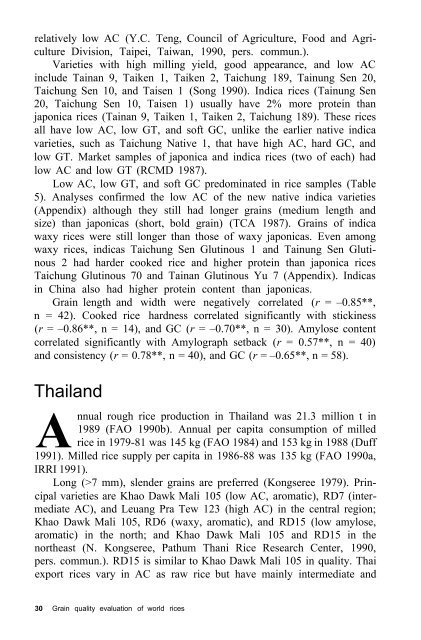Juliano et al. - 1993 - Grain Quality Evaluation of World Rices
Juliano et al. - 1993 - Grain Quality Evaluation of World Rices
Juliano et al. - 1993 - Grain Quality Evaluation of World Rices
Create successful ePaper yourself
Turn your PDF publications into a flip-book with our unique Google optimized e-Paper software.
elatively low AC (Y.C. Teng, Council <strong>of</strong> Agriculture, Food and Agriculture<br />
Division, Taipei, Taiwan, 1990, pers. commun.).<br />
Vari<strong>et</strong>ies with high milling yield, good appearance, and low AC<br />
include Tainan 9, Taiken 1, Taiken 2, Taichung 189, Tainung Sen 20,<br />
Taichung Sen 10, and Taisen 1 (Song 1990). Indica rices (Tainung Sen<br />
20, Taichung Sen 10, Taisen 1) usu<strong>al</strong>ly have 2% more protein than<br />
japonica rices (Tainan 9, Taiken 1, Taiken 2, Taichung 189). These rices<br />
<strong>al</strong>l have low AC, low GT, and s<strong>of</strong>t GC, unlike the earlier native indica<br />
vari<strong>et</strong>ies, such as Taichung Native 1, that have high AC, hard GC, and<br />
low GT. Mark<strong>et</strong> samples <strong>of</strong> japonica and indica rices (two <strong>of</strong> each) had<br />
low AC and low GT (RCMD 1987).<br />
Low AC, low GT, and s<strong>of</strong>t GC predominated in rice samples (Table<br />
5). An<strong>al</strong>yses confirmed the low AC <strong>of</strong> the new native indica vari<strong>et</strong>ies<br />
(Appendix) <strong>al</strong>though they still had longer grains (medium length and<br />
size) than japonicas (short, bold grain) (TCA 1987). <strong>Grain</strong>s <strong>of</strong> indica<br />
waxy rices were still longer than those <strong>of</strong> waxy japonicas. Even among<br />
waxy rices, indicas Taichung Sen Glutinous 1 and Tainung Sen Glutinous<br />
2 had harder cooked rice and higher protein than japonica rices<br />
Taichung Glutinous 70 and Tainan Glutinous Yu 7 (Appendix). Indicas<br />
in China <strong>al</strong>so had higher protein content than japonicas.<br />
<strong>Grain</strong> length and width were negatively correlated ( r = –0.85**,<br />
n = 42). Cooked rice hardness correlated significantly with stickiness<br />
( r = –0.86**, n = 14), and GC ( r = –0.70**, n = 30). Amylose content<br />
correlated significantly with Amylograph s<strong>et</strong>back ( r = 0.57**, n = 40)<br />
and consistency ( r = 0.78**, n = 40), and GC ( r = –0.65**, n = 58).<br />
Thailand<br />
A<br />
nnu<strong>al</strong><br />
rough rice production in Thailand was 21.3 million t in<br />
1989 (FAO 1990b). Annu<strong>al</strong> per capita consumption <strong>of</strong> milled<br />
rice in 1979-81 was 145 kg (FAO 1984) and 153 kg in 1988 (Duff<br />
1991). Milled rice supply per capita in 1986-88 was 135 kg (FAO 1990a,<br />
IRRI 1991) .<br />
Long (>7 mm), slender grains are preferred (Kongseree 1979). Princip<strong>al</strong><br />
vari<strong>et</strong>ies are Khao Dawk M<strong>al</strong>i 105 (low AC, aromatic), RD7 (intermediate<br />
AC), and Leuang Pra Tew 123 (high AC) in the centr<strong>al</strong> region;<br />
Khao Dawk M<strong>al</strong>i 105, RD6 (waxy, aromatic), and RD15 (low amylose,<br />
aromatic) in the north; and Khao Dawk M<strong>al</strong>i 105 and RD15 in the<br />
northeast (N. Kongseree, Pathum Thani Rice Research Center, 1990,<br />
pers. commun.). RD15 is similar to Khao Dawk M<strong>al</strong>i 105 in qu<strong>al</strong>ity. Thai<br />
export rices vary in AC as raw rice but have mainly intermediate and<br />
30 <strong>Grain</strong> qu<strong>al</strong>ity ev<strong>al</strong>uation <strong>of</strong> world rices

















